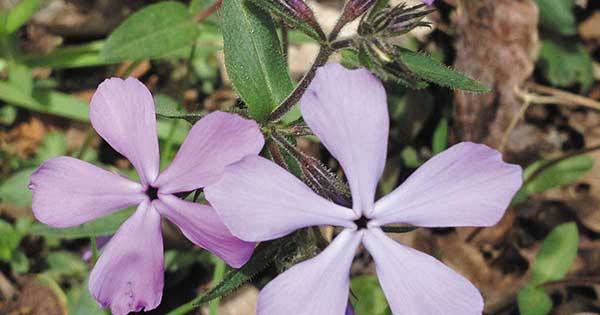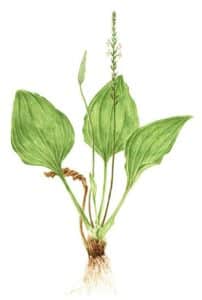How we characterize non-native plants and why it matters
As the spring days grow longer and the sun chases away the winter chill, our fields, woodlots, lawns, and gardens come alive with bursting buds, greening trees, and emerging bulbs. We may take a walk in the woods to catch our first glimpse of spring wildflowers. While we’re out, we notice shrubby Honeysuckles (Lonicera spp.), with their bright green, pointed leaves, emerging in droves throughout the understory. Wandering through our neighborhoods, we look forward to warmer days when our neighbor’s house is obscured by the tiny, densely packed leaves of the Privet hedge (Ligustrum vulgare). In the back garden, we spot snowy white Lily of the Valley (Convallaria majalis) and bright purple Crocuses (Crocus spp.) working their way through last season’s detritus, and we rejoice that spring has finally sprung.

While all these plants are common sights in Southeast Michigan and welcome signs of spring’s rebirth, none of them are native to the state, or even to the North American continent. But if they are not native, does that mean these plants, common in our woodlots, parks, neighborhoods, and gardens, are bad for the local environment? The answer is – it depends.
In ecology, the “10% rule” postulates that of all species introduced to a region outside of their native range, only 10% will survive to reproduce in their adopted environment. This 10% of non-native survivors are often called “naturalized” plants. Of that 10%, another 10% (or 1% of the original non-native transplants) may thrive to such an extent that they dominant their new home, out competing their native neighbors. These prolific competitors are known as invasive species.
Scientists define invasive species as plants or animals that harm regional ecosystems. While only a small percentage of non-native species go on to become invasive, invasive species can cause irreparable harm to local ecosystems by out competing their native counterparts due to an absence of natural predators or competition for resources. Invasive species can disrupt local ecologies, inhibiting natural succession and breaking down food webs. They can damage regional economies by impacting crop yields and fouling waterbodies; and they have acute impacts on cultural and spiritual connections to regional landscapes, particularly for indigenous peoples.
Regional impacts
The Great Lakes Region has suffered from numerous invasions of non-native species, imported by humans either intentionally or by accident. Plants like Honeysuckle, Privet, and Autumn Olive are intentionally planted for landscaping and to provide feed for wildlife, but they are aggressive competitors in forests and shrublands, shading out wildflowers and preventing the growth of tree seedlings. Even the lovely Lily of the Valley (the European variety) is invasive, with persistent and durable rhizomes (stems that grow underground) that proliferate through tough soils and out compete native plants in gardens, forests, and even grassy lawns.
But what about the other non-native species that do not become invasive? The term “naturalized” is used in botany to refer to plants that have successfully established and reproduced in a new environment. Naturalized species can become invasive, but most of them integrate into their new home without inflicting ecological harm (remember the 10% rule). Our friendly neighborhood Crocus is a prime example. Native to Europe, Asia, the Middle East, and North Africa, Crocuses are common in Michigan where they are generally regarded as non-aggressive plants and welcome harbingers of springtime in the Great Lakes.
It’s more than just a name

However, determining whether certain naturalized plants should be characterized as invasive or simply naturalized can be challenging. Many naturalized plants have been established in their “new” range for so long that ecosystems have fundamentally shifted and changed over time; local people develop cultural uses, associations, and connections with these plants as if they were a part of the native ecology; or mistake them for native species all together. Plants like Broadleaf plantain (Plantago major), used as medicine by indigenous peoples for generations, was introduced to North America by Europeans centuries ago and has since become commonplace in forests, grasslands, and sidewalk cracks across the continent. Queen Ann’s Lace (Daucus carota), a standard sight in the fields, pastures, and ditches of Southeast Michigan, could also be considered an established member of the Great Lakes plant community or an invasive weed, depending on who you ask.
In the end, the characterization and management of non-native plants comes down to an understanding of both ecological interactions and the inherent relationships we have with the plants themselves. Invasive species do not “invade” on their own; plants are not malicious. Many non-native species arrived in new places with humans who had a connection to the plants of their homeland and wanted to bring them along. Some of these immigrant plants have come to threaten native ecosystems, but many have become ubiquitous parts of our local environments and cultures.
As climate change threatens to upend regional ecosystems, our understanding and definition of non-native plants will be challenged even further. Many species will have to move outside of their native ranges to survive. With this migration comes a shift in ecological composition, competition between species, and local extinction of plants and animals unable to move on their own.
Our immigrant plant teachers offer a lot of different models for how not to make themselves welcome on a new continent [such as poisoning and crowding out the plants who came before them]. But Plantain is not like that. Its strategy was to be useful, to fit into small places, to coexist with others around the dooryard, to heal wounds. Plantain is so prevalent, so well integrated, that we think of it as native. It has earned the name bestowed by botanists for plants that have become our own. Plantain is not indigenous but ‘naturalized.’ This is the same term we use for the foreign-born when they become citizens in our country. —Dr. Robin Wall Kimmerer, Braiding Sweetgrass
Understanding the inherent relationships between people and plants can help us become better stewards of the land, from managing our local parks to making complex decisions about how to maintain ecosystems and help species survive in a changing world.
So before filling your yard with interesting looking shrubs, we recommend investigating whether a plant is characterized as invasive, native, or otherwise. Learn something about where your plants came from, the relationships that humans have had with them, and how they might interact with the environment where you want to plant them. So while you are out appreciating the spring wildflowers, take a moment to wonder at their names and how they came to live in Michigan.
For native plant tips and resources, go to HRWC.org/Landscaping. To help prevent the spread of aquatic invasive species, go to HRWC.org/Our-Watershed/Threats/Invasive-Species.
—Kate Laramie
This blog post is also published in the Huron River Report, Spring 2023.



